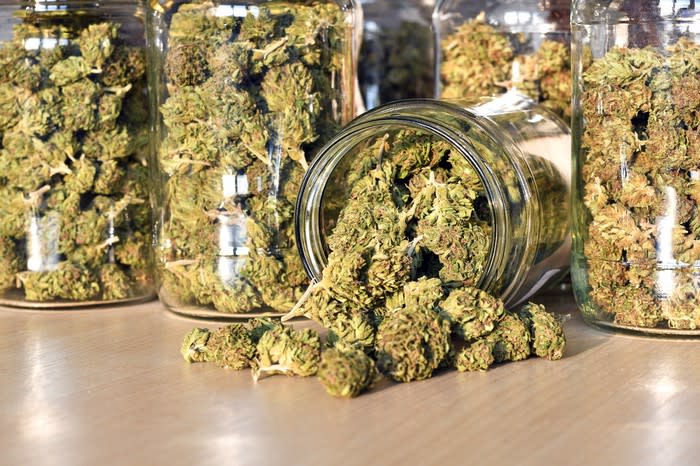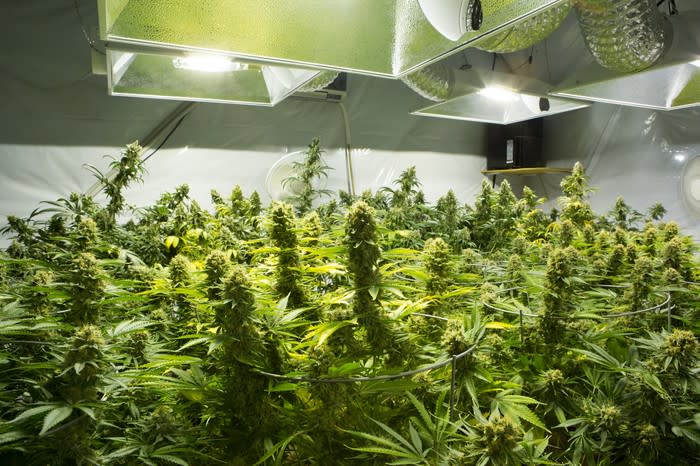4 of the Most Efficient Marijuana Stocks
The marijuana industry projects as a big-money business. Already on track for more than $14 billion in legal global sales in 2019, various Wall Street forecasts have opined that cannabis sales could hit $50 billion to $200 billion by the end of the next decade. That, presumably, leaves plenty of room for industry expansion, and for investors to make a boatload of money.
The problem is that there's a veritable laundry list of marijuana stocks to choose from, with new pot stocks coming to market on a fairly regular basis. That makes finding a place to begin your research somewhat challenging.
North America's most efficient cannabis growers
While it's by no means an end-all to your research, one of the best places to begin is by examining some of the most efficient cannabis growers. When I say "efficient," I'm talking about marijuana growers that look to be on the leading edge of the industry in terms of gram yield per square foot. Growers that can produce cannabis more efficiently than their peers would instantly gain a competitive edge that could translate into lower costs.
Below, you'll find four of what I believe will be the most efficient cannabis growers in North America.

Image source: Getty Images.
Flowr Corp.
Arguably the most impressive grower is a company that's completely off the radar for most investors. Small-cap Flowr Corp. (OTC: FLWPF) noted in a March 2019 investor presentation that most of its competition is able to produce marijuana with yields of 75 grams to 125 grams per square foot. In Flowr's opinion, this isn't sustainable over the long run from a production-cost perspective. Rather, Flowr was already delivering yields of more than 200 grams per square foot as of March 2019, and was on track for an estimated 300 grams per square foot by the end of the year.
And the company isn't finished. Flowr, which has its Kelowna campus in British Columbia laser-focused on producing premium and ultra-premium dried flower, is working hand-in-hand with Scotts Miracle-Gro's subsidiary Hawthorne Gardening to refine its growing methods to hit 400 grams of yield per square foot by 2022. Hawthorne has a variety of lighting solutions, nutrients, and soil options in can bring to the table, while Flowr can lean on its cannabis-growing knowledge and genetics to optimize yield.
It should be noted that Kelowna is no longer Flowr's only grow site. The company is developing 150,000 square feet of outdoor grow adjacent to Kelowna, 189,000 square feet (in aggregate) in 42 greenhouses (also adjacent to Kelowna), and recently purchased the remaining stake in outdoor grower Holigen that it didn't already own. Holigen's Aljustrel grow farm in Portugal spans roughly 7 million square feet and will yield in the neighborhood of 500,000 kilos a year. That's clearly a much lower yield than Flowr's average harvest at Kelowna, but the company should be given the benefit of the doubt since the deal was only announced two months ago.

Image source: Getty Images.
OrganiGram Holdings
No discussion of superior-yielding growers would be complete without New Brunswick-based OrganiGram Holdings (NASDAQ: OGI). OrganiGram has only one growing facility in Moncton, but is still considered a major grower given its 113,000 kilos of projected peak annual output.
What's really impressive about OrganiGram is that its Moncton growing space only accounts for about 490,000 square feet. This means that OrganiGram, when fully operational, should be producing a little bit more than 230 grams per square foot. Again, this is all based on the company's initial yields and projections as it moves forward with its phase 4 expansion, so it could change a bit. Nevertheless, there aren't any other major Canadian growers (i.e., producing north of 100,000 kilos a year) projected to yield north of 200 grams per square foot.
OrganiGram's secret sauce is that it employs three tiers of growing at its Moncton campus. Rather than utilizing a single-level growing system like all of its peers, OrganiGram is maximizing its available space and, as a result, should have some of the lowest production costs on a per-gram basis in the industry. This is one of the many reasons I expect OrganiGram to be one of the first Canadian weed growers to generate a recurring profit.

An aerial view of the Las Vegas Strip in Nevada at night. Image source: Getty Images.
Flower One Holdings
Another under-the-radar cannabis grower that might surprise you in terms of its efficiency is Flower One Holdings (OTC: FLOOF). Unlike the other companies on this list, Flower One is the only one focused on the U.S. market.
Flower One has the largest licensed grow facility in the state of Nevada. The company has 400,000 square feet of indoor grow space in North Las Vegas, as well as 55,000 square feet (at the same facility) that'll be used for processing and derivative production. Additionally, it has a separate cultivation facility in North Las Vegas spanning 25,000 square feet that was acquired via its NLV Organics purchase. Based on Flower One's most recent investor presentation, it expects continuous planting will yield 62,500 kilos per year at its primary facility, with a grand total of closer to 67,000 kilos a year with its smaller grow farm also mixed in. With 425,000 square feet of available grow space, this works out to about 158 grams per square foot, making Flower One highly efficient.
Flower One is an especially intriguing company given how lucrative the Nevada market could be in the United States. Even though it's not going to rival California in annual sales, the State of the Legal Cannabis Markets report from Arcview Market Research and BDS Analytics projects that Nevada will lead all states in per capita marijuana spending by 2024, with Nevada more than doubling up California.

Image source: Getty Images.
Aurora Cannabis
Last, but not least, is the largest marijuana producer in the world, Aurora Cannabis (NYSE: ACB). Aurora projects for at least 625,000 kilos of output by the end of June 2020, with peak production potentially nearing 700,000 kilos per year.
While I've had my reservations about Aurora Cannabis for a variety of reasons, one thing that isn't in question is the company's ability to grow marijuana efficiently on a large scale – especially in instances where Aurora constructs a facility from the ground up, rather than acquires the facility from another business. The company's already completed Aurora Sky campus should yield north of 100,000 kilos from 800,000 square feet of growing space (at least 125 grams per square foot), with Aurora Nordic 2 (at least 120 grams per square foot) and Aurora Sun (at least 142 grams per square foot) also delivering what I suspect will be above-average crop yields. These three campuses combine for at least 450,000 kilos of Aurora's annual peak output.
As with OrganiGram, though, construction is still ongoing. The flagship Aurora Sun facility, and its Scandinavian-focused Aurora Nordic 2 campus, won't be complete until mid-2020. But if Aurora Cannabis can meet or beat production expectations, based on listed capacity, it should be able to use economies of scale to its advantage to deliver some of the lowest production costs per gram in the industry.
More From The Motley Fool
Sean Williams has no position in any of the stocks mentioned. The Motley Fool recommends OrganiGram Holdings. The Motley Fool has a disclosure policy.
This article was originally published on Fool.com

